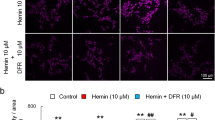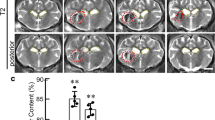Abstract
Iron overload plays a key role in brain injury after intracerebral hemorrhage (ICH). We explored the roles of ferric iron chelator—deferiprone (DFP)—and ferrous iron chelator—clioquinol (CQ)—in ICH rats through the outcomes, iron deposits, reactive oxygen species (ROS), brain water content, and related iron transporters. One hundred eight Sprague-Dawley rats received intra-striatal infusions of 0.5 U of type IV collagenase to establish ICH models. The rats were randomly assigned to the sham, vehicle, DFP, and CQ groups. We evaluated the outcomes, iron levels, brain water content, and ROS; meanwhile, immunohistochemistry and real-time quantitative polymerase chain reaction (RT-qPCR) were utilized to determine ferritin, transferrin, transferrin receptor, divalent metal transport 1 (DMT1), and ferroportin at 48 and 72 h, 7 and 14 days after surgery. Our results showed ICH induced iron overload, brain edema, ROS formation, and neurological deficits. Both iron chelators decreased iron levels; CQ improved the neurological outcome, attenuated brain edema, and ROS production. DFP reduced iron contents but not brain water content and ROS generation. DFP failed to improve the outcome. ICH initiated endogenous iron chelators and transporters, both exogenous iron chelators enhanced expression of transferrin and transferrin receptor. CQ enhanced expression of ferroportin but not DMT1, while DFP enhanced expression of DMT1 but not ferroportin. Ferrous iron contributed to brain injury, and binding ferrous iron can modestly improve outcome after ICH in rats. The exogenous ferrous iron chelator possibly functioned via endogenous ferrous iron transporters on ICH. Therefore, ferrous iron may be a promising target for ICH in future.







Similar content being viewed by others
References
Babu R, Bagley JH, Di C, Friedman AH, Adamson C (2012) Thrombin and hemin as central factors in the mechanisms of intracerebral hemorrhage-induced secondary brain injury and as potential targets for intervention. Neurosurg Focus 32:E8
Aronowski J, Zhao X (2011) Molecular pathophysiology of cerebral hemorrhage: secondary brain injury. Stroke 42:1781–1786
Gu Y, Hua Y, He Y, Wang L, Hu H, Keep RF et al (2011) Iron accumulation and DNA damage in a pig model of intracerebral hemorrhage. Acta Neurochir Suppl 111:123–128
Hatakeyama T, Okauchi M, Hua Y, Keep RF, Xi G (2013) Deferoxamine reduces neuronal death and hematoma lysis after intracerebral hemorrhage in aged rats. Transl Stroke Res 4:546–553
Pérez de la Ossa N, Sobrino T, Silva Y, Blanco M, Millán M, Gomis M et al (2010) Iron-related brain damage in patients with intracerebral hemorrhage. Stroke 41:810–813
Caliaperumal J, Wowk S, Jones S, Ma Y, Colbourne F (2013) Bipyridine, an iron chelator, does not lessen intracerebral iron-induced damage or improve outcome after intracerebral hemorrhagic stroke in rats. Transl Stroke Res 4:719–728
Xie Q, Gu Y, Hua Y, Liu W, Keep RF, Xi G (2014) Deferoxamine attenuates white matter injury in a piglet intracerebral hemorrhage model. Stroke 45:290–292
Auriat AM, Silasi G, Wei Z, Paquette R, Paterson P, Nichol H et al (2012) Ferric iron chelation lowers brain iron levels after intracerebral hemorrhage in rats but does not improve outcome. Exp Neurol 234:136–143
Atamna H, Frey WH 2nd (2004) A role for heme in Alzheimer’s disease: heme binds amyloid beta and has altered metabolism. Proc Natl Acad Sci U S A 101:11153–11158
Chun HJ, Kim DW, Yi HJ, Kim YS, Kim EH, Hwang SJ et al (2012) Effects of statin and deferoxamine administration on neurological outcomes in a rat model of intracerebral hemorrhage. Neurol Sci 33:289–296
Warkentin LM, Auriat AM, Wowk S, Colbourne F (2010) Failure of deferoxamine, an iron chelator, to improve outcome after collagenase-induced intracerebral hemorrhage in rats. Brain Res 1309:95–103
Kontoghiorghes GJ, Efstathiou A, Kleanthous M, Michaelides Y, Kolnagou A (2009) Risk/benefit assessment, advantages over other drugs and targeting methods in the use of deferiprone as a pharmaceutical antioxidant in iron loading and non-iron loading conditions. Hemoglobin 33:386–397
Abbruzzese G, Cossu G, Balocco M, Marchese R, Murgia D, Melis M et al (2011) A pilot trial of deferiprone for neurodegeneration with brain iron accumulation. Haematologica 96:1708–1711
Prachayasittikul V, Prachayasittikul S, Ruchirawat S, Prachayasittikul V (2013) 8-Hydroxyquinolines: a review of their metal chelating properties and medicinal applications. Drug Des Devel Ther 7:1157–1178
Garcia JH, Wagner S, Liu KF, Hu XJ (1995) Neurological deficit and extent of neuronal necrosis attributable to middle cerebral artery occlusion in rats. Statistical validation. Stroke 26:627–634
Jolkkonen J, Jokivarsi K, Laitinen T, Gröhn O (2007) Subacute hemorrhage and resolution of edema in Rose Bengal stroke model in rats coincides with improved sensorimotor functions. Neurosci Lett 428:99–102
Shao A, Wang Z, Wu H, Dong X, Li Y, Tu S, Tang J, Zhao M et al (2014) Enhancement of autophagy by histone deacetylase inhibitor trichostatin A ameliorates neuronal apoptosis after subarachnoid hemorrhage in rats. Mol Neurobiol 2014 Nov 18
Prohaska JR, Gybina AA (2005) Rat brain iron concentration is lower following perinatal copper deficiency. J Neurochem 93:698–705
Chen S, Ren Q, Zhang J, Ye Y, Zhang Z, Xu Y et al (2014) N-acetyl-L-cysteine protects against cadmium-induced neuronal apoptosis by inhibiting ROS-dependent activation of Akt/mTOR pathway in mouse brain. Neuropathol Appl Neurobiol 40:759–777
Livak KJ, Schmittgen TD (2001) Analysis of relative gene expression data using real-time quantitative PCR and the 2(-Delta DeltaC(T)) method. Methods 25:402–408
Iranmanesh M, Fatemi SJ, Ebrahimpour R, Dahooee Balooch F (2013) Chelation of chromium(VI) by combining deferasirox and deferiprone in rats. Biometals 26:465–471
Markesbery WR (1997) Oxidative stress hypothesis in Alzheimer’s disease. Free Radic Biol Med 23:134–147
Arosio P, Levi S (2010) Cytosolic and mitochondrial ferritins in the regulation of cellular iron homeostasis and oxidative damage. Biochim Biophys Acta 1800:783–792
Reif DW (1992) Ferritin as a source of iron for oxidative damage. Free Radic Biol Med 12:417–427
Jayasena T, Grant RS, Keerthisinghe N, Solaja I, Smythe GA (2007) Membrane permeability of redox active metal chelators: an important element in reducing hydroxyl radical induced NAD+ depletion in neuronal cells. Neurosci Res 57:454–461
Lemire JA, Harrison JJ, Turner RJ (2013) Antimicrobial activity of metals: mechanisms, molecular targets and applications. Nat Rev Microbiol 11:371–384
Cai X, Chen X, Wang X, Xu C, Guo Q, Zhu L et al (2013) Pre-protective effect of lipoic acid on injury induced by H2O2 in IPEC-J2 cells. Mol Cell Biochem 378:73–78
Tsubaki T, Honma Y, Hoshi M (1971) Neurological syndrome associated with clioquinol. Lancet 1:696–697
Meade TW (1975) Subacute myelo-optic neuropathy and clioquinol. An epidemiological case-history for diagnosis. Br J Prev Soc Med 29:157–169
Regland B, Lehmann W, Abedini I, Blennow K, Jonsson M, Karlsson I et al (2001) Treatment of Alzheimer’s disease with clioquinol. Dement Geriatr Cogn Disord 12:408–414
Ritchie CW, Bush AI, Mackinnon A, Macfarlane S, Mastwyk M, MacGregor L et al (2003) Metal-protein attenuation with iodochlorhydroxyquin (clioquinol) targeting abeta amyloid deposition and toxicity in Alzheimer disease: a pilot phase 2 clinical trial. Arch Neurol 60:1685–1691
Kühn LC (2015) Iron regulatory proteins and their role in controlling iron metabolism. Metallomics 7:232–243
Jefferies WA, Brandon MR, Hunt SV, Williams AF, Gatter KC, Mason DY (1984) Transferrin receptor on endothelium of brain capillaries. Nature 312:162–163
Gkouvatsos K, Papanikolaou G, Pantopoulos K (2012) Regulation of iron transport and the role of transferrin. Biochim Biophys Acta 1820:188–202
Xie L, Zheng W, Xin N, Xie JW, Wang T, Wang ZY (2012) Ebselen inhibits iron-induced tau phosphorylation by attenuating DMT1 up-regulation and cellular iron uptake. Neurochem Int 61:334–340
Li L, Li YW, Zhao JY, Liu YZ, Holscher C (2009) Quantitative analysis of iron concentration and expression of ferroportin 1 in the cortex and hippocampus of rats induced by cerebral ischemia. J Clin Neurosci 16:1466–1472
Zhang Z, Hou L, Song JL, Song N, Sun YJ, Lin X et al (2014) Pro-inflammatory cytokine-mediated ferroportin down-regulation contributes to the nigral iron accumulation in lipopolysaccharide-induced Parkinsonian models. Neuroscience 257:20–30
Song N, Wang J, Jiang H, Xie J (2010) Ferroportin 1 but not hephaestin contributes to iron accumulation in a cell model of Parkinson’s disease. Free Radic Biol Med 48:332–341
Acknowledgments
This work was supported by the Shanxi provincial Science and Technology Agency (2014011041-5) and Shanxi provincial Hygiene Department (201301010).
Author information
Authors and Affiliations
Corresponding author
Rights and permissions
About this article
Cite this article
Wang, G., Hu, W., Tang, Q. et al. Effect Comparison of Both Iron Chelators on Outcomes, Iron Deposit, and Iron Transporters After Intracerebral Hemorrhage in Rats. Mol Neurobiol 53, 3576–3585 (2016). https://doi.org/10.1007/s12035-015-9302-3
Received:
Accepted:
Published:
Issue Date:
DOI: https://doi.org/10.1007/s12035-015-9302-3




